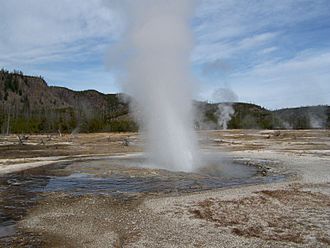Jewel Geyser facts for kids
Quick facts for kids Jewel Geyser |
|
|---|---|

Jewel Geyser
|
|
| Name origin | named for the beads of pearly sinter around the geyser's vent. |
| Location | Biscuit Basin, Upper Geyser Basin, Yellowstone National Park, Wyoming |
| Coordinates | 44°29′06″N 110°51′22″W / 44.4849062°N 110.8561833°W |
| Elevation | 7,798 feet (2,377 m) |
| Type | Fountain geyser |
| Eruption height | up to 20 ft |
| Frequency | 8-9 minutes |
| Duration | seconds |
| Temperature | 86.5 °C (187.7 °F) |
Jewel Geyser is a cool geyser found in Yellowstone National Park in the United States. It's located in the famous Upper Geyser Basin. A geyser is like a natural hot water fountain. It shoots hot water and steam high into the air from deep underground.
Jewel Geyser is known for its beautiful look and how often it erupts. It's a special part of Yellowstone's amazing hot spring areas.
About Jewel Geyser
Jewel Geyser is a type of geyser called a "fountain geyser." This means it erupts from a pool of water, sending water up in a wide, gushing column. It's not like a single jet of water.
Where is Jewel Geyser?
You can find Jewel Geyser in an area called Biscuit Basin. This basin is part of the larger Upper Geyser Basin in Yellowstone National Park. Biscuit Basin has many other interesting hot springs and geysers. Some of these include Black Diamond Pool, Sapphire Pool, and Black Pearl Geyser.
What Makes it Special?
Jewel Geyser gets its name because of the shiny, pearl-like rocks around its opening. These rocks are called sinter. Sinter is a type of mineral deposit left behind by the hot water. The beads of sinter around Jewel Geyser's vent look like tiny jewels.
When Jewel Geyser erupts, it can shoot water up to 20 feet (about 6 meters) high! These eruptions usually last only a few seconds. The geyser erupts quite often, usually every 8 to 9 minutes. The water in Jewel Geyser is very hot, reaching about 86.5 degrees Celsius (187.7 degrees Fahrenheit).
History of its Name
Jewel Geyser wasn't always called by its current name. When it was first discovered by the Hayden Survey, it was named Soda Geyser. This survey was an important expedition that explored Yellowstone in the late 1800s.
Later, in 1887, a person named Arnold Hague renamed it Jewel Geyser. He likely chose this name because of the beautiful, shiny sinter deposits around the geyser's vent.

